Anne Lyle's Blog
September 9, 2015
Beyond Bullet Journal – this time it’s personal!
As I’ve been blogging about for the past few weeks, I’ve taken up bullet journaling as a way to get myself more organised and productive. My little Midori Passport now goes everywhere with me, as both to-do list and writer’s notebook, and I love it – but I wasn’t so happy with the rest of my setup. For my to-do lists, BuJo (as it’s apparently known in the community) is perfect, but for personal journals it’s just too, well, impersonal. I wanted something that captured my creative life in more detail than a dry list of activities.
Because, let’s face it, we’ve all seen awesome-looking journals in movies and TV shows, whether it’s Indiana Jones’ archaeological secrets, or the Hunters’ notebooks that feature in the TV show Supernatural – and whilst most people’s lives may be far less exciting (and admittedly lacking the deadly traps and soul-sucking demons), they’re still full of moments worth recording.
 Journal scene from “Indiana Jones and the Last Crusade”
Journal scene from “Indiana Jones and the Last Crusade”It was while I was researching different versions of the chronodex and spiraldex that I came across vlogger Klair Scattergood aka Rhomany, a British mixed media artist who teaches online. I liked her chatty style and her approach to organisation, so I looked into her work further and discovered that in addition to her free YouTube videos she runs paid courses, including one on journaling. It’s called When Frogs Sing and is a mixture of planning and organisation, art lessons and creative writing exercises. Perfect!
I’ve been trying to get back into drawing for a while now—and spent a fair amount of money on art materials—but have been frustrated with the rustiness of my skills after a couple of decades of neglect. Hence a refresher course starting from first principles sounded ideal. I wasn’t so interested in the writing exercises, but figured I could use this section of the course to work on some of Holly Lisle’s workshops that I’ve been meaning to redo for a while. For one thing, I really need to work on my “story bible”, i.e. worldbuilding plus character dossiers – the material I need to support my new project but which never seems to get done because I’m trying to write the damned book!
In mid-August I signed up for WFS 2015; you can start any time, and can even do last year’s course instead if you prefer a more flexible syllabus. They’re very good value for the amount of teaching material you get (mainly videos, with some PDFs for the writing exercises): a three-week taster course from WFS 2014 is £10, whilst WFS 2015 is available either as four quarterly mini-courses at £30 each or you can sign up for a whole year’s worth for £99.

The course includes an optional component: an additional “self-improvement” project of your choosing that you can pursue over the course of the year. I use the word self-improvement in its very broadest sense: class members are doing everything from bible study to Unfuck Your Habitat. The latter is far more my style (and gods know, my habitat could do with some unfucking!), so I unearthed a nice Filofax from the depths of my desk and have set that up as my household planner, as described in last week’s post.
For my creative journalling and novel planning I have:
Midori “Passport” Traveller’s Notebook – contains plain and lined inserts for doodling and story notes (as well as a gridded insert for my planner/bullet journal)
Standard Midori Traveller’s Notebook with three inserts:
Gridded paper for day-per-page personal journal
Plain paper for art class exercises
Lined paper for bullet journal “collections” – book lists and so on – and long-term planning
Tom Bihn Field Journal Notebook for general writing notes (non-book-specific)
X17 (A5-sized) for series bible
Four inserts, plain and lined
plus of course lots of pens, coloured pencils and other art materials for the coursework. As you can see in the photo below, I’ve already adorned both Midoris with cute charms – apparently, in addition to my usual fox fetish I now also have a thing about wols!
 What secrets lie within?
What secrets lie within?The X17 inserts are all micro-perforated, and the plan is to eventually take them apart and file the individual pages in an A5 binder – probably the big leather Filofax that’s been gathering dust on my desk for some time. It won’t be quite as glamorous as Indy’s journal, but on the other hand it zips up all the way round, which should protect the contents from sacrificial blood and other messy accidents!
At first I was worried I wouldn’t have anything to put in my journal every day, but so far I haven’t had any problem coming up with topics. It helps that by the time I’ve included a mini spiraldex and a handful of bullet points for what I’m reading/knitting/watching on TV, I only have space for a couple of paragraphs of text and a small drawing or photo. For the most part it’s pretty mundane stuff, but that’s the point of a personal journal: to capture the extraordinary within the ordinary, whether it’s seeing a rainbow for the first time in ages or enjoying a delicious strawberry sorbet cone on one of the last hot days of the year. I feel it’s already making me more mindful of my surroundings and activities, and I’m looking forward to including more sketches and decorative elements in future entries.
The hard part will be ensuring that this fun new hobby doesn’t eat into my writing time, but let’s face it – writers are expert procrastinators anyway. If we weren’t, social media would be a much quieter place!
Beyond Bullet Journal – this time it’s personal!
As I’ve been blogging about for the past few weeks, I’ve taken up bullet journaling as a way to get myself more organised and productive. My little Midori Passport now goes everywhere with me, as both to-do list and writer’s notebook, and I love it – but I wasn’t so happy with the rest of my setup. For my to-do lists, BuJo (as it’s apparently known in the community) is perfect, but for personal journals it’s just too, well, impersonal. I wanted something that captured my creative life in more detail than a dry list of activities.
Because, let’s face it, we’ve all seen awesome-looking journals in movies and TV shows, whether it’s Indiana Jones’ archaeological secrets, or the Hunters’ notebooks that feature in the TV show Supernatural – and whilst most people’s lives may be far less exciting (and admittedly lacking the deadly traps and soul-sucking demons), they’re still full of moments worth recording.
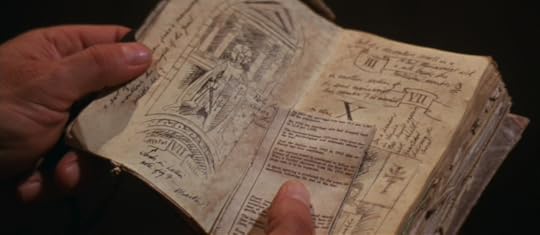 Journal scene from “Indiana Jones and the Last Crusade”
Journal scene from “Indiana Jones and the Last Crusade”For my creative journalling and novel planning I now have:
Midori “Passport” Traveller’s Notebook – contains plain and lined inserts for doodling and story notes (as well as a gridded insert for my planner/bullet journal)
Standard Midori Traveller’s Notebook with three inserts:
Gridded paper for day-per-page personal journal
Plain paper for art class exercises
Lined paper for bullet journal “collections” – book lists and so on – and long-term planning
Tom Bihn Field Journal Notebook for general writing notes (non-book-specific)
X17 (A5-sized) for series bible
Four inserts, plain and lined
plus of course lots of pens, coloured pencils and other art materials. As you can see in the photo below, I’ve already adorned both Midoris with cute charms – apparently, in addition to my usual fox fetish I now also have a thing about wols!
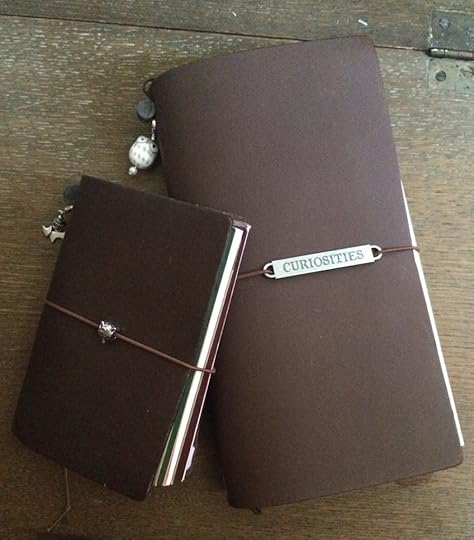 What secrets lie within?
What secrets lie within?The X17 inserts are all micro-perforated, and the plan is to eventually take them apart and file the individual pages in an A5 binder – probably the big leather Filofax that’s been gathering dust on my desk for some time. It won’t be quite as glamorous as Indy’s journal, but on the other hand it zips up all the way round, which should protect the contents from sacrificial blood and other messy accidents!
At first I was worried I wouldn’t have anything to put in my journal every day, but so far I haven’t had any problem coming up with topics. It helps that by the time I’ve included a mini spiraldex and a handful of bullet points for what I’m reading/knitting/watching on TV, I only have space for a couple of paragraphs of text and a small drawing or photo. For the most part it’s pretty mundane stuff, but that’s the point of a personal journal: to capture the extraordinary within the ordinary, whether it’s seeing a rainbow for the first time in ages or enjoying a delicious strawberry sorbet cone on one of the last hot days of the year. I feel it’s already making me more mindful of my surroundings and activities, and I’m looking forward to including more sketches and decorative elements in future entries.
The hard part will be ensuring that this fun new hobby doesn’t eat into my writing time, but let’s face it – writers are expert procrastinators anyway. If we weren’t, social media would be a much quieter place!
September 1, 2015
Bullet Journal, GTD and forward planning
Whilst I love the structure and simplicity of Bullet Journal, there’s no denying that the basic system is weak on planning. Unfortunately that’s something I have to do a lot of, both in my day job and at home. For example if I’m attending a convention I need to make sure to book my train or plane tickets well in advance, when they’re cheapest – but that may not be today or even next month or the month after that.
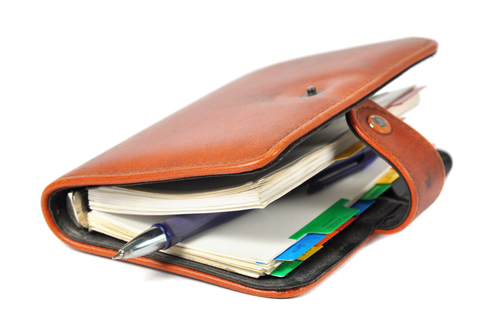 What would we do without Filofaxes?
What would we do without Filofaxes?The other issue is that if I put absolutely everything into one journal, each notebook is going to fill up pretty quickly, which means a lot of copying of long-term items from one to the next. Whilst I understand that the purpose of copying items is to help you decide what’s important to you and what can be discarded, this doesn’t really apply to things that are on hold because they simply can’t be done right now.
One solution would be to use a binder that allows you to switch sections in and out, such as a Filofax or a refillable notebook such as an X17 or Midori. Either way, you’re looking at hauling around a substantial-sized journal – imagine pulling out that monster in the supermarket, just to tick off an item on your shopping list! And if you lost it, all your plans would be lost too…
The alternative that I’ve come up with is to have not one but three journals. Yes, this does break the Bullet Journal model of having one place for everything, but it solves a lot of other problems. Also, as you’ll see, most of the time you’re only using one journal anyway.
Household Planner
The first “journal” is the least-often used, but the most long-term. I use it for all my domestic projects (e.g. room makeovers) and also to log reminders for the things I do year after year at a particular time (like making preserves in autumn). It rarely if ever leaves the house, because its sole purpose is planning.
For this I use a Filofax (a personal-sized Malden), because it’s easy to add pages here and there as I need them. Funnily enough I originally bought it to be my take-anywhere “story bible” for my novels but found the pages too small for the job, which is why I switched to A5 paper for that project.
I have a pre-printed foldout year planner marked with birthdays and major household events (using some cute Filofax stickers I bought years ago and never used!), then dividers for months and “zones” (major areas of the house) where I add loose pages as needed. It’s very much a work-in-progress, but I aim for it to become an invaluable reference as the years go by.
Personal Journal
The second journal is for medium-term and more personal stuff. For this I use a Midori Traveller’s Notebook, which I’d been lusting after for ages. I’d looked into them when I was choosing a story bible notebook last year, but as with the Filofax I was put off by the narrow, non-standard paper size. However for a personal journal there’s no real need to be constrained by format, so I went a bit crazy and bought the MTN and inserts, plus a bunch of pretty stickers and post-its, from The Journal Shop 
 All The Pretties!
All The Pretties!I have two inserts in there at the moment: my daily journal/diary, and my personal project lists. I’ll talk more about the former in another post, as it’s the latter that’s most pertinent to bullet journalling. The only ‘BuJo’ content in my personal journal is the monthly two-page spread, with an overview of events and a to-do list for important time-sensitive tasks.
The Project List insert starts with the obligatory index/contents page, then has a page per Collection, i.e. a bullet list for a particular topic. This includes books I want to read, upcoming TV shows (and DVD releases) I don’t want to miss, and of course a list of conventions I’m thinking of attending with accompanying to-do lists for each one. Anything that, in GTD terms, would be categorised as “Someday/Maybe” gets an asterisk instead of a checkbox, but otherwise I don’t distinguish between these and Next Actions – I prefer to group items by topic rather than time-frame.
Because I only put longer-term projects in here, not day-to-day trivia, I expect this insert to last quite a long time. Hence at the back are several 6-months-to-two-pages spreads, covering at least the next two years. Here I fill in the big events I need to plan well ahead, like the aforementioned conventions. The first page of this planner section is marked with washi tape down the edge, so I can find it more easily.
Pocket Journal
This is the journal I carry with me everywhere. I started out using my little X17, but the paper turned out to not be fountain-pen-friendly so I’ve invested in a Midori Passport Traveller’s Notebook, which is about the same size. It contains three inserts (plus storage pockets): a sketchbook and lined notebook for creative work, and a grid-paper insert for my hybrid planner/bullet journal. In GTD terms it holds Next Actions and also serves as a Bucket, i.e. a place to jot down everything that occurs to me during the day. This can include one-bullet notes about major projects, which I will process later.
I did start this one out as a conventional bullet journal, but again found the lack of forward planning somewhat frustrating. I’m therefore using a format I saw in the YouTube video below*, but since the MTN Passport is smaller, mine has only two days per page. To keep it flexible I’m setting up each week by hand on the gridded paper rather than using pre-printed inserts – it only takes a few minutes and makes me feel more engaged in the planning process.
* To-do layout starts around 9:30 mins into the video
This format has the advantage that I don’t have to move tasks from day to day, only week to week – though of course I try to complete each week’s tasks by Sunday evening!
Putting it all together
The key to making all of this work is the daily review. Every morning I take out my Personal and Pocket journals and plan my day:
Add anything new that I need to get done before the end of the week to the Pocket Journal.
Go through “notes” bullets from the previous day and for each one, decide whether it belongs in my Personal Journal or Household Planner.
At the end of each month I also review my Personal Journal and Household Planner, setting up the next month’s pages in the former and looking for long-term projects that have tasks I can finally start.
That’s all there is to it! It’s a long way from the bullet journal ideal of one-notebook-for-everything, but it suits the way I like to compartmentalise my activities. To use GTD terminology, each journal is a context: when I’m at work, all I see is work tasks; when I’m writing, I’m not being sidetracked by household responsibilities, and so on. It also has the benefit of greatly reducing the chance of losing all your information at once, which is always the fear with an analogue system.
Next time: singing with frogs as I plan my creative year!
Bullet Journal, GTD and forward planning
While I love the structure and simplicity of Bullet Journal, there’s no denying that the basic system is weak on planning. Unfortunately that’s something I have to do a lot of, both in my day job and at home. For example if I’m attending a convention I need to make sure to book my train or plane tickets well in advance, when they’re cheapest – but that may not be today or even next month or the month after that.
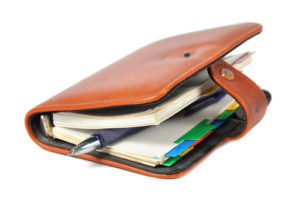 What would we do without Filofaxes?
What would we do without Filofaxes?The other issue is that if I put absolutely everything into one journal, each notebook is going to fill up pretty quickly, which means a lot of copying of long-term items from one to the next. Whilst I understand that the purpose of copying items is to help you decide what’s important to you and what can be discarded, this doesn’t really apply to things that are on hold because they simply can’t be done right now.
One solution would be to use a binder that allows you to switch sections in and out, such as a Filofax or a refillable notebook such as an X17 or Midori. Either way, you’re looking at hauling around a substantial-sized journal – imagine pulling out that monster in the supermarket, just to tick off an item on your shopping list! And if you lost it, all your plans would be lost too…
The alternative that I’ve come up with is to have not one but three journals. Yes, this does break the Bullet Journal model of having one place for everything, but it solves a lot of other problems. Also, as you’ll see, most of the time you’re only using one journal anyway.
Household Planner
The first “journal” is the least-often used, but the most long-term. I use it for all my domestic projects (e.g. room makeovers) and also to log reminders for the things I do year after year at a particular time (like making preserves in autumn). It rarely if ever leaves the house, because its sole purpose is planning.
For this I use a Filofax (a personal-sized Malden), because it’s easy to add pages here and there as I need them. Funnily enough I originally bought it to be my take-anywhere “story bible” for my novels but found the pages too small for the job, which is why I switched to A5 paper for that project.
I have a pre-printed foldout year planner marked with birthdays and major household events (using some cute Filofax stickers I bought years ago and never used!), then dividers for months and “zones” (major areas of the house) where I add loose pages as needed. It’s very much a work-in-progress, but I aim for it to become an invaluable reference as the years go by.
Personal Journal
The second journal is for medium-term and more personal stuff. For this I use a Midori Traveller’s Notebook, which I’d been lusting after for ages. I’d looked into them when I was choosing a story bible notebook last year, but as with the Filofax I was put off by the narrow, non-standard paper size. However for a personal journal there’s no real need to be constrained by format, so I went a bit crazy and bought the MTN and inserts, plus a bunch of pretty stickers and post-its, from The Journal Shop 
August 26, 2015
Bullet Journal + Spiraldex
As mentioned in my earlier posts about Bullet Journal, I like to keep my personal and day-job notebooks completely separate, so that I’m not fretting about work issues when I’m at home and vice versa. However another reason is that the two areas need very different management styles.
 Do Not Feed the Elephants
Do Not Feed the ElephantsMy day job is funded by a number of different research grants, and each funding body wants to know how their money is being spent. I therefore need to log my activities on a pretty fine-grained level (15 minute increments is the recommendation), and each activity needs enough space to record what was done and for which grant.A summary of this information gets transferred to an electronic timesheet system at the end of each month, and my journal provides a more detailed paper trail should the auditors ever decide to pay us a visit…
For this type of log, a conventional “appointments calendar” layout is ideal. I use a Leuchtturm with dotted grid paper and write out each day’s calendar as I get to it – it only takes a few moments each morning, and allows me to intersperse my time log with pages of notes on specific topics, designs for web pages, and so on. I don’t really do much bullet-journalling in this notebook any more, since I manage my ToDos electronically using Omnifocus.
For my personal timekeeping, on the other hand, the emphasis is on improving productivity – I’m much more interested in the type of activity than the details of which task was done. How much time am I spending consuming content (TV, films, games, internet) compared to producing it (fiction, blog posts, drawing)? This is where Spiraldex comes in.
Spiraldex is a modification by Kent of Oz of Chronodex, which was created by Patrick Ng as a way of graphically recording your day’s activity using the metaphor of an analogue clock. You decide what activity categories you want to log, assign each one a colour, then fill in the diagram as appropriate. I’m using a further-modified version (left) that starts at midnight instead of 6am – perfect for night owls, shift-workers or weird people like me who wake at the crack of dawn!
Just to be thorough, I log my creative activities in three separate categories: writing, including outlining and editing; author business, which is anything writing-related but not actual work on the prose, i.e. everything from blogging to doing my accounts; and “other”. This last is a catch-all category for my non-writing hobbies (journalling, drawing, knitting, spinning) and also reading, which is a more active pursuit than merely consuming media, as well as (in the case of reading fiction) tangentially related to my writing career.
I’ve created a PDF with a dozen copies of the diagram on it, so I just need to print out a sheet every couple of weeks and cut them out. Each day I pop a blank spiraldex into my Midori Passport and transfer it to my MTN when I complete my day’s journal entry.
Designing data visualisation is something I do regularly in my day-job, so I appreciate the elegance of this method – it gives you an instant visual summary of your day, which means there’s no getting away from the fact that you spent three hours watching Doctor Who when you should have been writing! I’ve only been using been using it a few weeks, and already it’s making me more productive.
August 18, 2015
Nine Worlds 2015
The other weekend I was at the third Nine Worlds Geekfest, down in London, and I have to say I had an absolute blast. The atmosphere was as friendly and welcoming as ever, there were loads of interesting talks and activities going on, and of course plenty of cosplay!
 All geek life is here!
All geek life is here!I arrived on Saturday afternoon, and spent a few hours catching up with friends and having an excellent dinner at a local pub, The Three Magpies. However I was utterly shattered after the slog down from Cambridge in sweltering summer heat, so I decided to have an early night. After all, I had a 9am panel the next day…
The panel went really well – I met up with Sebastian de Castell in the foyer so we got some ideas flowing, and Amy Alward did an excellent job of moderating at very short notice. Since I didn’t have any more events scheduled after that, I spent the rest of the day in other panels or at the Stitch’n’Natter up on the fourth floor.
Nine Worlds has such a great mix of tracks on its schedule, from straightforward SF&F to academic talks to hands-on crafting, it’s hard to pick the stuff you want to see! This year I mainly went to the history talks, partly because my friend Max introduced me to one of the speakers, John Johnston, when I was mingling on Friday afternoon but mostly because I am of course a huge history geek 
I went to two of his panels: Historical Head-canon and Favourite Historical Movies. The former was a kind of “what if?” discussion, with each historian presenting a hypothesis that is fun to talk about but too lacking in evidence to be publishable, like the idea that Claudius could have been behind the conspiracy to assassinate his predecessor Caligula. In the latter talk, each speaker talked us through a favourite movie set in the past: Hammer Horror’s 1958 Dracula, Richard Lester’s The Three/Four Musketeers and the more recent Formula 1 biopic Rush. Of course now I want to (re)watch all of them!
On Saturday evening I had dinner in the hotel restaurant with writer friends Emma and Pete Newman, Gareth Powell, Michaela Gray and Steve Aryan, then it was off upstairs for a book launch (with free wine!) and then barconning until midnight.
One disappointment this year was that there was no weekend-long dealers’ room. Instead there were a couple of permanent stalls in the atrium (notably Genki Gear, who were selling the official con t-shirt), plus a pop-up market on Sunday. Presumably this worked well for the small vendors who might not have been able to afford an all-weekend slot, but it must have been disappointing for the Saturday-only attendees.
 Ooh, shiny!
Ooh, shiny!However I did manage to snap up some goodies. I couldn’t resist buying a skein of sock yarn from Third Vault Yarns, especially when I found a lovely dark green-and-blue colourway called “Loki”. However my real find was a necklace from the neighbouring stall, Ravens Jewellery. Although the inspiration behind the designs is Game of Thrones, the one I bought has particular relevance to the project I’m working on at the moment, so I had to have it. Not that I’m going to tell you (yet) why it’s so significant – I’m cruel like that 
My other treasure from the con is a Firefly-themed cushion (below), which I won at the English PEN‘s Equality Now charity auction on Sunday, after a fierce bidding war with a fellow fan. It now has pride of place in my study, next to my fox cushion which is in similar colours. (If you’re interested in the fabric, you can buy it from Spoonflower.com, which is a bit like CafePress but for fabric and paper.)
 Yes sir, Cap’n Tightpants!
Yes sir, Cap’n Tightpants!My only real complaint about the convention is the hotel, which was clearly struggling with an event of this size. In particular there were nowhere near enough bar staff, leading to long queues; fortunately geeks are pretty polite people, so no riots broke out! However I wasn’t surprised to learn that the convention will be relocating next year (venue TBC), so hopefully there will be better service as well as more circulation space. Whatever happens, I’ll be there!
Nine Worlds 2016 will take place in London from 12th – 14th August, and you can buy early-bird tickets now!
August 6, 2015
Franken-plotting, or The Indecisive Gardener
George R R Martin calls them architects and gardeners; most other writers call them plotters and pantsers. Either way, there’s general agreement that all writers fall somewhere on a spectrum between detailed up-front planning and complete seat-of-the-pants improvisation. I fall towards the latter end of the spectrum. I wish I could plot a novel before I start writing—it seems much more efficient—but that doesn’t seem to work for me. Instead, I’ve gravitated towards what I call Franken-plotting.
 It’s a good thing I write on my laptop!
It’s a good thing I write on my laptop!Whereas other writers boast/complain of having loads of different unrelated story ideas, I tend to have one core idea for a plot/setting and another couple for characters, and then lots of “satellite” ideas as to how these core elements will play out in the story. The trouble is, these options are often mutually exclusive, and my left brain and right brain find it hard to agree on which is the best, so I end up writing at least a scene or two for each one – and sometimes many chapters.
This certainly happened with the Night’s Masque series, which started out as a secondary world murder mystery and ended up as an alternate history spy thriller! All that remains of the original idea is the 16th-century urban setting, the fantasy element (skraylings) and the main characters of Mal, Ned, Coby and Kiiren – and even they changed somewhat in the retelling.
Usually, the idea that wins out is the one I get furthest with, but that doesn’t mean I have to discard all the other attempts. Lately I’ve been finding there’s great synergy in taking two or more versions of the story and stitching together the best bits into a greater whole.
That’s what I’m doing at the moment. I have 35,000+ words of last autumn’s draft, which has some solid material in the later chapters, but I’m not so keen on this version of the protagonist. Hence I’m taking another, more recent draft of his opening chapters, and adding them to Act Two of the longer draft. It’s going to take some editing to make the two marry together, but editing is my favourite part of writing. Better still, the ideas from the two drafts have combined to inspire some cool stuff for the second half of the novel, so at last I have a vague notion of where I’m heading.
Anyway, that’s why it takes me so long to get going on a new project. Once I’ve settled on a final version my writing speeds up a lot, so I’m hoping I can get this Franken-draft finished in the next few months. After that it will still be a while before it’s ready to send to my agent, and who knows how long after that before it gets published.
As Hippocrates said over two thousand years ago, Ho bios brakhys, hê de tekhnê makrê*
To which I can only reply: Allons-y!
 Photo: BBC
Photo: BBC* Life is short, the craft is long
Franken-plotting, or The Indecisive Gardener
George R R Martin calls them architects and gardeners; most other writers call them plotters and pantsers. Either way, there’s general agreement that all writers fall somewhere on a spectrum between detailed up-front planning and complete seat-of-the-pants improvisation. I fall towards the latter end of the spectrum. I wish I could plot a novel before I start writing—it seems much more efficient—but that doesn’t seem to work for me. Instead, I’ve gravitated towards what I call Franken-plotting.
 It’s a good thing I write on my laptop!
It’s a good thing I write on my laptop!Whereas other writers boast/complain of having loads of different unrelated story ideas, I tend to have one core idea for a plot/setting and another couple for characters, and then lots of “satellite” ideas as to how these core elements will play out in the story. The trouble is, these options are often mutually exclusive, and my left brain and right brain find it hard to agree on which is the best, so I end up writing at least a scene or two for each one – and sometimes many chapters.
This certainly happened with The Alchemist of Souls, which started out as a secondary world murder mystery and ended up as an alternate history spy thriller! All that remains of the original idea is the 16th-century urban setting, the fantasy element (skraylings) and the main characters of Mal, Ned, Coby and Kiiren – and even they changed somewhat in the retelling.
Usually, the idea that wins out is the one I get furthest with, but that doesn’t mean I have to discard all the other attempts. Lately I’ve been finding there’s great synergy in taking two or more versions of the story and stitching together the best bits into a greater whole.
That’s what I’m doing at the moment. I have 35,000+ words of last autumn’s draft, which has some solid material in the later chapters, but I’m not so keen on this version of the protagonist. Hence I’m taking another, more recent draft of his opening chapters, and adding them to Act Two of the longer draft. It’s going to take some editing to make the two marry together, but editing is my favourite part of writing. Better still, the ideas from the two drafts have combined to inspire some cool stuff for the second half of the novel, so at last I have a vague notion of where I’m heading.
Anyway, that’s why it takes me so long to get going on a new project. Once I’ve settled on a final version my writing speeds up a lot, so I’m hoping I can get this Franken-draft finished in the next few months. After that it will still be a while before it’s ready to send to my agent, and who knows how long after that before it gets published.
As Hippocrates said over two thousand years ago, Ho bios brakhys, hê de tekhnê makrê*
To which I can only reply: Allons-y!
[image error]David Tennant as the Tenth Doctor (Photo: BBC)
* Life is short, the craft is long
August 1, 2015
Bullet Journal update – the stationery porn edition!
Following my decision to start a bullet journal, I had to decide what kind of notebook and pens to use. I considered using my LiveScribe Echo, but that would limit me to black ink and the narrow range of available dot-paper notebooks, so I’ve opted to go completely analogue this time – which gives me the excuse to really indulge my stationery addiction!
I hunted through my drawer of unused notebooks (I did mention I had an addiction, right?) and found a lime green Leuchtturm that a friend gave me at Easter when she was visiting from Germany. I’d never used this brand before, but since I wasn’t crazy about the lime green colour I thought it might do for my day-job bullet journal.
 Not going to lose this one in a hurry!
Not going to lose this one in a hurry!When I unwrapped it I found it was an even better choice than I’d expected. Not only are the pages pre-numbered, but all Leuchtturm notebooks have several printed table-of-contents pages at the front, ready for a Bullet Journal index. They also come with a set of stickers for labelling the front and spine of your notebook; the latter are particularly useful if you want to shelve your notebooks and refer to them later.
I immediately started filling in the pages, using a Parker fountain pen that writes nicely but isn’t so expensive that I’d be devastated if I lost it at the office. By lucky chance my friend had chosen the dotted grid version of the notebook, which is perfect for Bullet Journal format because it makes it easy to line up your bullets vertically.
 Pristine journals, awaiting the pen…
Pristine journals, awaiting the pen…The process went really well, so I decided to get another Leuchtturm for my personal journal. Unfortunately we have only one local stockist (Ryman), and they only carry the plain and ruled paper versions. I could have ordered online from elsewhere, but then they would have taken several days to arrive and I was impatient to begin! I therefore decided to buy a lined Leuchtturm locally, and will order some dotted-paper ones for when the first is full. I’m not so keen on the lined paper ones, though, as they have “Date:” at the top of each page, which is only useful if you are writing a more conventional journal. Note that I actually bought two notebooks – the special edition gold one was on discount, so I couldn’t resist!
 Click to see a close-up!
Click to see a close-up!Of course notebooks are no good without pens, and as I’ve blogged about before, I particularly love fountain pens. The ones I’m using with my personal journals are by Kaweco: a Lilliput in eco (lead-free) brass, and a Classic Sport in limited-edition dark brown. I’ve photographed them next to a UK 20p piece (slightly smaller than a US quarter), so you can see how tiny they are!
Both are loaded with brown ink, which I think is nicer than stark black for a personal journal. The Lilliput is on the expensive side so it stays at home (I lost my first one through carrying it around in my backpack), hence I bought the much cheaper Classic Sport for travel use.
 This one goes everywhere with me
This one goes everywhere with meIn addition to the Leuchtturms I’m going to be using my X17 re-formed leather A6 binder with two lined-paper inserts, as my take-everywhere to-do list and general mental dumping ground. The X17 was one of the notebooks I bought for earlier this year for writing on-the-go, but it happens to suit bullet journaling really well.
I use a Zebra Expandz telescoping ballpoint pen with this one because, much as I love fountain pens, their tendency to dry up is not helpful when you’re trying to jot stuff down whenever and wherever you think of it. I love these Zebra pens (and their even tinier siblings), as they can slip into the smallest pocket or utility belt pouch!
I also wanted to use coloured pens with my new journals, so I dug out a set of Uniball Signo gel pens I’d bought from John Lewis a while back and added some Bic ballpoints (the clicky multi-coloured kind we all loved as kids!) for carrying around in my various work/leisure bags.
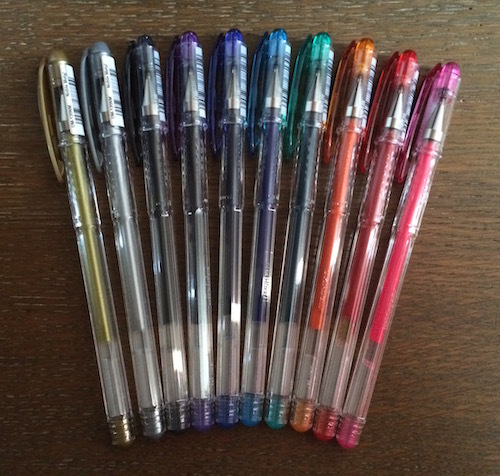 I love that these come in gold and silver as well!
I love that these come in gold and silver as well!For highlighting I use fluorescent pencils from Paperchase, because unlike conventional fibre-tip highlighters they don’t bleed through to the other side of the paper. Plus, being pencils you can also cut them in half to make nifty pocket versions!
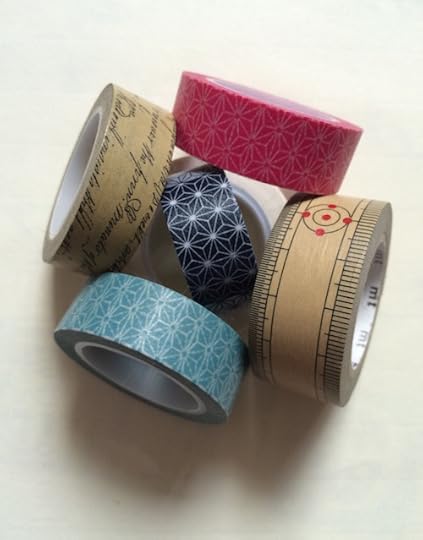 More pretties
More prettiesFinally I decided to buy some washi tape for brightening up my journals – it’s a type of decorative Japanese paper tape with a similar feel to masking tape, and very popular with scrapbookers, card makers and other crafters. The choice available locally was very limited, so I ordered several designs from Lovely Tape.
I’ve been journalling for a couple of weeks now, and whilst none of the above are essential, they certainly help to keep me motivated!
Bullet Journal update – the stationery porn edition!
Following my decision to start a bullet journal, I had to decide what kind of notebook and pens to use. I considered using my LiveScribe Echo, but that would limit me to black ink and the narrow range of available dot-paper notebooks, so I’ve opted to go completely analogue this time – which gives me the excuse to really indulge my stationery addiction!
I hunted through my drawer of unused notebooks (I did mention I had an addiction, right?) and found a lime green Leuchtturm that a friend gave me at Easter when she was visiting from Germany. I’d never used this brand before, but since I wasn’t crazy about the lime green colour I thought it might do for my day-job bullet journal.
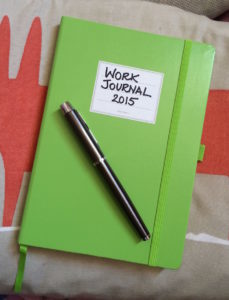 Not going to lose this one in a hurry!
Not going to lose this one in a hurry!When I unwrapped it I found it was an even better choice than I’d expected. Not only are the pages pre-numbered, but all Leuchtturm notebooks have several printed table-of-contents pages at the front, ready for a Bullet Journal index. They also come with a set of stickers for labelling the front and spine of your notebook; the latter are particularly useful if you want to shelve your notebooks and refer to them later.
I immediately started filling in the pages, using a Parker fountain pen that writes nicely but isn’t so expensive that I’d be devastated if I lost it at the office. By lucky chance my friend had chosen the dotted grid version of the notebook, which is perfect for Bullet Journal format because it makes it easy to line up your bullets vertically.
 Pristine journals, awaiting the pen…
Pristine journals, awaiting the pen…The process went really well, so I decided to get another Leuchtturm for my personal journal. Unfortunately we have only one local stockist (Ryman), and they only carry the plain and ruled paper versions. I could have ordered online from elsewhere, but then they would have taken several days to arrive and I was impatient to begin! I therefore decided to buy a lined Leuchtturm locally, and will order some dotted-paper ones for when the first is full. I’m not so keen on the lined paper ones, though, as they have “Date:” at the top of each page, which is only useful if you are writing a more conventional journal. Note that I actually bought two notebooks – the special edition gold one was on discount, so I couldn’t resist!
Of course notebooks are no good without pens, and as I’ve blogged about before, I particularly love fountain pens. The ones I’m using with my personal journals are by Kaweco: a Lilliput in eco (lead-free) brass, and a Classic Sport in limited-edition dark brown. I’ve photographed them next to a UK 20p piece (slightly smaller than a US quarter), so you can see how tiny they are!
 Click to see a close-up!
Click to see a close-up!Both are loaded with brown ink, which I think is nicer than stark black for a personal journal. The Lilliput is on the expensive side so it stays at home (I lost my first one through carrying it around in my backpack), hence I bought the much cheaper Classic Sport for travel use.
In addition to the Leuchtturms I’m going to be using my X17 re-formed leather A6 binder with two lined-paper inserts, as my take-everywhere to-do list and general mental dumping ground. The X17 was one of the notebooks I bought for earlier this year for writing on-the-go, but it happens to suit bullet journaling really well.
I use a Zebra Expandz telescoping ballpoint pen with this one because, much as I love fountain pens, their tendency to dry up is not helpful when you’re trying to jot stuff down whenever and wherever you think of it. I love these Zebra pens (and their even tinier siblings), as they can slip into the smallest pocket or utility belt pouch!
I also wanted to use coloured pens with my new journals, so I dug out a set of Uniball Signo gel pens I’d bought from John Lewis a while back and added some Bic ballpoints (the clicky multi-coloured kind we all loved as kids!) for carrying around in my various work/leisure bags.
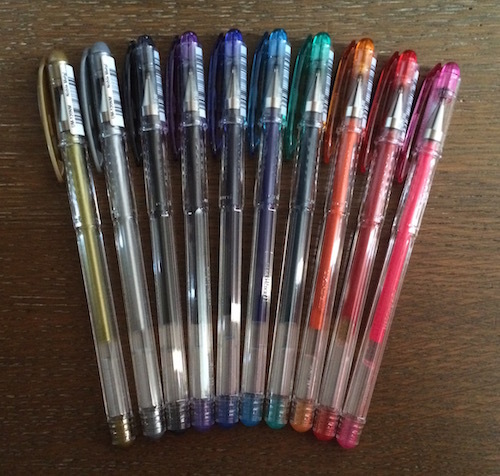 I love that these come in gold and silver as well!
I love that these come in gold and silver as well!For highlighting I use fluorescent pencils from Paperchase, because unlike conventional fibre-tip highlighters they don’t bleed through to the other side of the paper. Plus, being pencils you can also cut them in half to make nifty pocket versions!
 More pretties
More prettiesFinally I decided to buy some washi tape for brightening up my journals – it’s a type of decorative Japanese paper tape with a similar feel to masking tape, and very popular with scrapbookers, card makers and other crafters. The choice available locally was very limited, so I ordered several designs online.
I’ve been journalling for a couple of weeks now, and whilst none of the above are essential, they certainly help to keep me motivated!




